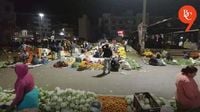India is experiencing a severe heatwave that has gripped many regions, with temperatures soaring to alarming levels. On Monday, April 21, 2025, Chandrapur in Maharashtra's Vidarbha region recorded the highest temperature in the country at a blistering 45.6°C, narrowly missing the area's all-time April record of 46.4°C set in 1996. This extreme heat is causing disruptions across various sectors, particularly in agriculture, where rising temperatures are impacting the vegetable supply chain.
In Pune, maximum temperatures have been consistently above seasonal averages, with Lohegaon registering 42°C and Shivajinagar recording 39.9°C—1.7 degrees above normal. The Indian Meteorological Department (IMD) has forecasted that daytime temperatures across most parts of Pune will remain in the 40–42°C range until at least April 27.
As the heatwave intensifies, other areas in Maharashtra are also feeling the heat. Solapur recorded 43°C, while regions in Vidarbha, such as Brahmapuri, Amravati, Akola, and Nagpur, reported temperatures of 45°C, 44.6°C, 44.1°C, and 43.6°C, respectively. The IMD attributes the high temperatures to hot air advection from northwestern India, a phenomenon common during the pre-monsoon season.
Across the country, several other hotspots include Jharsuguda in Odisha at 45.4°C and Sidhi in Madhya Pradesh at 44.5°C. The IMD has issued heatwave warnings for multiple states, including Madhya Pradesh, Maharashtra's Vidarbha region, Chhattisgarh, Odisha, Haryana, and Uttar Pradesh, with alerts extending until April 26 in some areas.
The current heatwave is not just a temporary spike; the IMD predicts a significantly higher number of heatwave days than usual, especially over Rajasthan, Gujarat, Punjab, Haryana, Delhi, Uttar Pradesh, and western Madhya Pradesh. The temperatures in these regions are expected to remain elevated, with many locations exceeding 40°C. For instance, Delhi recorded a maximum temperature of 41.3°C on April 22, which is 3.6 degrees above average.
In Mumbai, temperatures reached 33.5°C on April 21, with a yellow alert issued by the IMD for the city and surrounding areas, expecting hot weather and humidity to prevail until at least April 23. The forecast indicates that temperatures could rise to 36°C in Mumbai and as high as 39°C in Thane later this week.
The ongoing heatwave is causing significant disruptions in the vegetable supply chain in Pune. As temperatures rise, farmers are facing water shortages and increased evaporation, which hinder plant growth and lower overall output. The volume of fresh produce arriving at Pune's Shri Chhatrapati Shivaji Market Yard has dropped compared to cooler months, leading to noticeable price increases for key vegetables.
Over the past month, prices of green vegetables and summer-sensitive crops have surged by at least 30%. For example, okra wholesale rates have jumped to ₹50-70/kg, while retail prices have reached ₹110-120/kg. Similarly, eggplant is now retailing at ₹110-120/kg, up from ₹25-70/kg earlier in the year. Fenugreek, once available at ₹2/bunch, now costs ₹10/bunch wholesale and ₹30-40/bunch at retail.
Other vegetables like cabbage and cauliflower are now priced at ₹50-60/kg in retail markets, up from ₹10-25/kg wholesale earlier. Leafy greens such as coriander and spinach have also seen substantial price hikes, with wholesale rates for coriander ranging from ₹500-1,000 per hundredweight and spinach at ₹800-1,000 per hundredweight.
Traders report that the number of trucks and tempos arriving daily at the Market Yard has dropped from over 100 during peak season, leading to price volatility for vegetables like tomatoes, cucumbers, beans, and peas. While some vegetables have seen stable or even declining prices due to increased arrivals from other states, the overall trend for green vegetables remains upward.
Consumers are feeling the pinch as household budgets stretch due to rising costs of daily essentials. Many are opting for more affordable vegetables or reducing their consumption of costlier greens and summer-sensitive items. Traders express concern that further supply drops could occur if the heatwave persists or if water shortages worsen in key farming regions.
Experts warn that unless there is relief from the heat or improved irrigation in growing areas, the upward trend in prices is likely to continue through May and June. Farmers are exploring alternative crops that require less water, which may further impact the supply of traditional vegetables in the short term.
As India braces for a prolonged heatwave, the IMD has also predicted heavy to very heavy rainfall in northeastern states like Assam, Meghalaya, and Arunachal Pradesh from April 22 to 24, accompanied by strong winds and thunderstorms. This contrasting weather pattern highlights the varied climatic challenges the country faces as it enters the summer months.
With extreme temperatures and their repercussions on agriculture and daily life, residents and officials alike are urged to stay vigilant and prepared for the ongoing heatwave conditions.







